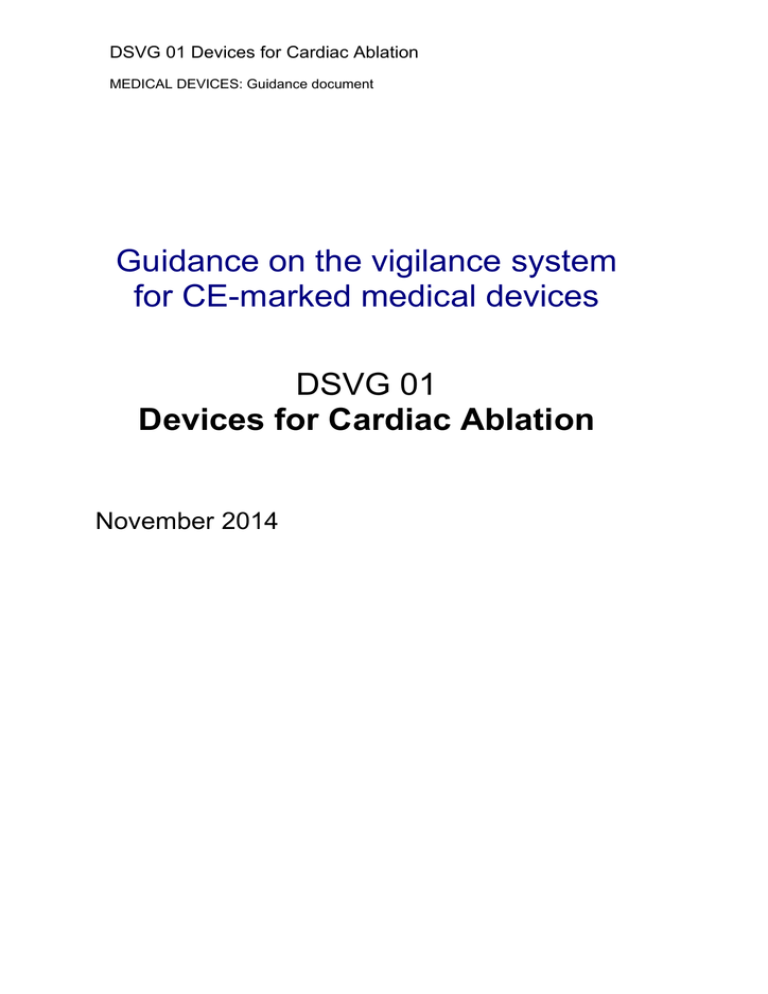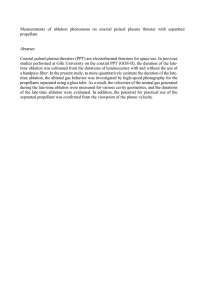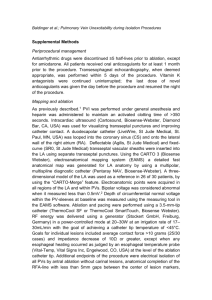DSVG 01
advertisement

DSVG 01 Devices for Cardiac Ablation MEDICAL DEVICES: Guidance document Guidance on the vigilance system for CE-marked medical devices DSVG 01 Devices for Cardiac Ablation November 2014 DSVG 01 Devices for Cardiac Ablation MEDICAL DEVICES: Guidance document Contents 1 Introduction .......................................................................................................... 1 2 What Individual Incidents Should Be Reported ................................................ 1 3 Periodic Summary Reporting .............................................................................. 1 4 Trend Reporting .................................................................................................. 2 5 Clinical Reference Guidelines ............................................................................. 2 6 References ............................................................................................................ 2 DSVG 01 Devices for Cardiac Ablation MEDICAL DEVICES: Guidance document 1. Introduction This document provides guidance for manufacturers of Devices for Cardiac Ablation. It outlines specific scenarios that should be considered when determining if an incident is reportable. This document should be read in conjunction with DSVG00: Introduction to Device Specific Vigilance Guidance. The aim of this guidance is to complement the requirements of the Medical Devices Directive [1] and the MEDDEV [2] and should be read in conjunction with the aforementioned. Device specific guidance does not replace or extend these requirements. 2. What Individual Incidents Should Be Reported The following list details Devices for Cardiac Ablation examples indicating what should be reported as device performance problems that caused or contributed to the incident. The list is for illustrative purposes only and does not constitute an exhaustive list: • • • • • • • • • • ablation catheter introduction or withdrawal issues mechanical problem with ablation catheter (e.g. tip fracture, entrapment of multipolar ablation catheters) incidents relating to ablation accessories or equipment failure ablation energy delivery problems excessive coagulum appearance on the ablation catheter electrode or distal shaft of the catheter excessive ablation electrode charring as defined by the operating clinician or user saline or medium leak (e.g. cryo fluid) cardiac ablation system parameter anomalies (e.g. temperature or impedance value, alarm or display warning malfunction) which result in patient injury failure to deliver pacing energy where the device may have contributed to death or serious deterioration in health, and the manufacturer is unable to obtain clarification within the reporting timeframes as to whether a device malfunction caused the incident it should be reported Note: The use of the term excessive coagulum in these circumstances is a subjective term based on the individual clinician’s experience. 3. Periodic Summary Reporting The following are examples of Devices for Cardiac Ablation incidents, which following agreement with a Competent Authority, may be considered for periodic summary reporting. The list is for illustrative purposes only and does not constitute an exhaustive list: • post FSCA adverse incidents DSVG 01 Devices for Cardiac Ablation MEDICAL DEVICES: Guidance document 4. Trend Reporting The following Devices for Cardiac Ablation incident examples are for illustrative purposes only and do not constitute an exhaustive list: • • • • • • • • • • • • • stroke with an onset of symptoms within 72 hours of the procedure myocardial infarction with an onset of symptoms within 72 hours of the procedure transient ischaemic attack with an onset of symptoms within 72 hours of the procedure pulmonary embolism with an onset of symptoms within 72 hours of the procedure cardiac perforation / pericardial effusion / tamponade unexplained death or serious injury phrenic nerve paralysis with an onset of symptoms within 72 hours of the procedure ablation popping collateral tissue damage e.g. damage to oesophagus or other non-intended tissue damage following ablation angina exacerbation with an onset of symptoms within 72 hours of the procedure coagulum (non-excessive) appearance on the ablation catheter electrode or distal shaft of the catheter ablation electrode charring (non-excessive) cardiac pacing issues encountered during the procedure, which did not require intervention to mitigate serious injury or death Some of the above incidents may be more appropriate for Periodic Summary Reporting. Any of the above incidents that meet the Vigilance criteria should be reported on an individual basis. 5. Clinical Reference Guidelines Clinical reference guidelines for a specific device may be of use to manufacturers when identifying incident examples and complications. Current clinical guidelines for cardiac therapeutic procedures, expert consensus statements and current analysis of complications can be found on the European Society of Cardiology’s web-site. 6. References 1. Council Directive 93/42/EEC concerning Medical Devices, OJ L169 of 12 July 1993, last amended by Directive 2007/47/EC. 2. The European Commission Guidelines on a Medical Devices Vigilance System, MEDDEV 2.12-1 rev 8, January 2013





